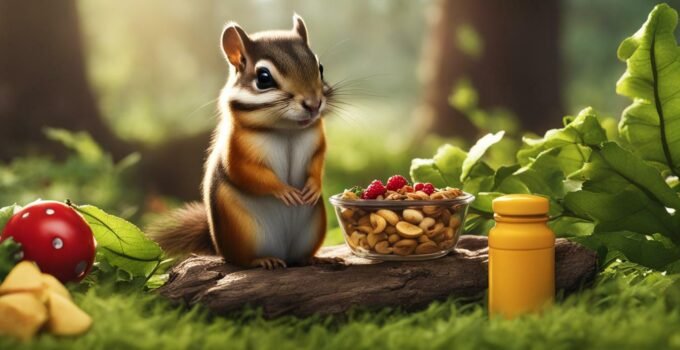Understanding the Unique Needs of Chipmunks
Before bringing a chipmunk into your home, it’s important to familiarize yourself with their unique needs and requirements. Chipmunks are small rodents that belong to the squirrel family and are primarily found in North America. In their natural habitat, chipmunks live in forest areas and create long burrows in the roots of shrubs and trees.
Chipmunks have a varied diet, which includes cereals, grains, seeds, fruits, and insects. When choosing a chipmunk as a pet, it is recommended to buy from a reputable breeder in the spring or summer when the chipmunks are most active. This ensures that you are getting a healthy and well-socialized pet.
The cage for a pet chipmunk should be as large as possible and should have a closed house or nesting area where they can retreat and feel safe. It is also important to provide them with plenty of opportunities for exercise and enrichment. This can be achieved by including toys, platforms for climbing, and tunnels for them to explore.
When it comes to their diet, a pet chipmunk’s food should include a combination of cereals, sunflower seeds, nuts, fruits, and specially formulated chipmunk food available at pet stores. It’s important to follow basic care rules such as not letting the chipmunk escape, providing food for winter stockpiling, and ensuring each chipmunk has its own cage. Regular cleaning of the cage is essential to maintain a healthy environment for your pet.
Chipmunk Diet
| Food | Portion Size |
|---|---|
| Cereals | A small handful |
| Sunflower seeds | A few seeds |
| Nuts | 1-2 nuts |
| Fruits | Small portions |
| Specially formulated chipmunk food | As directed on the package |
Chipmunks can live up to 10 years in captivity with proper care. However, it’s important to remember that they are wild animals and may not thrive as pets if not provided with the necessary resources and environment. Therefore, it is crucial to research and consult with experts to ensure that you can meet the needs of a chipmunk before deciding to bring one into your home.
In case you come across a baby chipmunk that may be orphaned, it is best to consult with a local wildlife agency or wildlife rehabber for help. They will have the knowledge and resources to provide the necessary care and ensure the well-being of the baby chipmunk.
Creating a Suitable Habitat for Your Pet Chipmunk
Providing a comfortable and secure habitat is crucial for the well-being of your pet chipmunk. These small rodents have specific needs that must be met to ensure their health and happiness. When setting up their living quarters, it is important to consider their natural behaviors and provide an environment that mimics their wild habitat.
A spacious cage or enclosure is essential for your chipmunk to have enough room to move around and engage in natural behaviors. The cage should be made of sturdy materials to prevent escape and have a closed house or nesting area where your chipmunk can retreat for privacy and security.
As burrowing animals, chipmunks require a substrate that allows them to dig and create tunnels. A combination of soil, shredded newspaper, and aspen bedding can be used to provide a comfortable and suitable substrate for your pet chipmunk to burrow and nest in. It is important to regularly clean and replace the substrate to maintain cleanliness and prevent odors.
| Important Considerations for Chipmunk Habitat: |
|---|
| Provide plenty of branches and perches for climbing and exercising. |
| Ensure the cage is well-ventilated to prevent respiratory issues. |
| Offer hiding spots such as tunnels or boxes for your chipmunk to feel secure. |
| Place chew toys and gnawing blocks in the cage to help satisfy their natural instinct to gnaw and prevent dental problems. |
| Keep the cage away from direct sunlight and drafts to maintain a comfortable temperature. |
By providing a suitable and enriching habitat for your pet chipmunk, you are ensuring their overall well-being and helping them thrive in captivity. Remember to monitor their behavior and make any necessary adjustments to their environment to ensure they are happy and healthy.
Providing a Nutritious Diet for Your Chipmunk
A healthy diet is vital to ensure your chipmunk’s overall well-being and longevity. Chipmunks have specific dietary needs that must be met in order to keep them healthy and happy. Here are some key considerations for providing a nutritious diet for your pet chipmunk:
- Chipmunk Specialized Food: You can find specially formulated chipmunk food at pet stores. These foods are designed to provide the necessary nutritional balance for your chipmunk’s diet. They typically contain a mix of cereals, grains, nuts, and seeds that closely resemble the chipmunk’s natural diet.
- Fruits and Vegetables: In addition to specialized food, you can also offer your chipmunk a variety of fresh fruits and vegetables. Apples, bananas, carrots, and leafy greens like spinach and lettuce are all excellent choices. Ensure that the fruits and vegetables are thoroughly washed before feeding.
- Nuts and Seeds: Chipmunks love nuts and seeds, and these can be a healthy addition to their diet. Almonds, walnuts, sunflower seeds, and pumpkin seeds are all suitable options. However, it’s important to offer these in moderation, as they can be high in fat.
- Protein: Chipmunks are omnivores, and they need a source of protein in their diet. Insects like mealworms and crickets can be provided as occasional treats. You can find dried insects specifically made for pet chipmunks at specialty pet stores.
- Water: Always ensure that your chipmunk has access to fresh, clean water. Use a water bottle with a sipper tube attached to the cage, as this helps prevent spills and keeps the water clean.
Remember that a balanced diet is key to maintaining your chipmunk’s health. It’s important to avoid feeding your chipmunk foods that are high in sugar, salt, or unhealthy fats. Additionally, monitor your chipmunk’s weight regularly to ensure they are not becoming overweight, as this can lead to health problems.
Here’s a sample table showing a daily chipmunk diet:
| Food Type | Quantity |
|---|---|
| Specialized Chipmunk Food | 1-2 tablespoons |
| Fresh Fruits and Vegetables | 1-2 tablespoons |
| Nuts and Seeds | 1 teaspoon |
| Protein (Insects) | 1-2 times a week as a treat |
“A healthy chipmunk is a happy chipmunk. Providing a nutritious and balanced diet is one of the vital aspects of caring for your pet chipmunk.” – Chipmunk Expert
By following these guidelines and consulting with your veterinarian, you can ensure that your chipmunk receives the proper nutrition it needs for a long and healthy life.
Exercise and Enrichment for a Happy Chipmunk
Chipmunks are highly energetic animals that require regular exercise and mental stimulation to thrive in captivity. Providing opportunities for physical activity and enrichment is essential for their overall well-being.
Indoor and Outdoor Exercise
To satisfy their high energy levels, allow your pet chipmunk regular exercise both indoors and outdoors. Inside the house, create a safe and secure play area where your chipmunk can roam freely. Make sure the area is escape-proof and free from any hazardous objects or toxic substances. Providing climbing structures such as branches, ramps, or tunnels can stimulate their natural instincts to explore and climb.
Outdoor playtime in a secure and supervised space is also beneficial for chipmunks. Consider creating a small enclosed yard or constructing a secure outdoor enclosure where they can safely enjoy fresh air, natural sunlight, and opportunities to forage and dig.
Enrichment Activities and Toys
Keeping your chipmunk mentally stimulated is equally important. Provide a variety of interactive toys and activities that encourage natural behaviors like foraging, chewing, and climbing. Puzzle feeders, treat balls, and hiding treats inside cardboard tubes or boxes can engage their natural instincts and keep them mentally stimulated. Incorporate different textures such as branches, rocks, and leaves into their environment to provide sensory enrichment.
Offering safe items like bird feathers, non-toxic chew toys, and branches with bark still intact can help satisfy their natural urge to chew. Regularly rotating and introducing new toys and objects can prevent boredom and keep your chipmunk entertained.
A Balanced Approach
While it’s important to provide ample exercise and enrichment, it’s equally crucial to respect your chipmunk’s need for rest and relaxation. Ensure they have a cozy nesting area within their habitat where they can retreat and sleep comfortably. Create a calming environment by minimizing loud noises and disturbances, especially during their designated sleeping hours.
Remember, each chipmunk has its own personality and preferences, so observe their behavior and adapt their exercise and enrichment routines accordingly. By providing a stimulating and nurturing environment, you can help your pet chipmunk lead a happy and fulfilling life.
| Key Points | |
|---|---|
| Chipmunks require regular exercise and mental stimulation. | Provide both indoor and outdoor play areas. |
| Offer climbing structures and safe objects for exploration. | Rotate toys and provide interactive activities. |
| Respect their need for rest and relaxation. | Observe their behavior and adjust routines accordingly. |
Maintaining Good Health and Preventing Illness
Keeping your chipmunk healthy is a top priority to ensure a long and happy life together. As an omnivore, providing a balanced and nutritious diet is crucial for your chipmunk’s wellbeing. A combination of commercial chipmunk food, supplemented with fresh fruits, vegetables, nuts, and seeds, will provide the necessary nutrients for their overall health.
In addition to a proper diet, regular health check-ups are essential to identify any potential issues early on. It is important to handle your chipmunk with care and practice proper hygiene, as they can be susceptible to certain diseases and parasites. If you notice any changes in your chipmunk’s behavior, appetite, or appearance, it is recommended to consult a veterinarian experienced in exotic animal care.
Creating a suitable environment for your chipmunk is equally important. Ensure their cage is spacious enough for them to move around and engage in natural behaviors. Provide ample opportunities for exercise, such as offering climbing branches or introducing interactive toys, to keep them mentally stimulated and physically active.
Proper handling and training techniques are vital for both your chipmunk’s safety and your own. Take time to socialize and bond with your pet chipmunk, using positive reinforcement methods to establish trust and build a strong relationship. This will help reduce stress and prevent any behavior issues that may arise.
| Tips for Maintaining Good Chipmunk Health: | |
|---|---|
| 1. | Provide a balanced diet consisting of commercial chipmunk food, fresh fruits, vegetables, nuts, and seeds. |
| 2. | Schedule regular veterinary check-ups to monitor your chipmunk’s overall health and address any concerns. |
| 3. | Keep the chipmunk’s cage clean and hygienic to prevent the spread of bacteria and parasites. |
| 4. | Ensure the cage is spacious and includes opportunities for exercise and mental stimulation. |
| 5. | Handle your chipmunk gently and practice proper hygiene to minimize stress and minimize the risk of injury. |
Socialization and Interaction with Your Pet Chipmunk
Building a trusting relationship with your chipmunk is key to their emotional well-being and overall happiness. Chipmunks are naturally social animals, and while they may not crave constant attention like some pets, they still benefit greatly from daily interaction and socialization. By nurturing a bond with your chipmunk, you can ensure that they feel safe, secure, and loved in their new home.
When handling a pet chipmunk, it is important to approach them with gentleness and patience. Allow them to become familiar with your scent by placing your hand near their cage initially and gradually working up to gentle strokes and handling. Avoid sudden movements or loud noises that may startle them. Using treats as positive reinforcement can also help them associate handling with positive experiences.
If you have multiple chipmunks, it’s essential to introduce them gradually and supervise their interactions. While some chipmunks may form close bonds and enjoy living in a small colony, others may prefer a solitary lifestyle. Observe their behavior and adjust their living arrangements accordingly. Providing separate cages for each chipmunk is also crucial to prevent territorial disputes.
Enrichment activities are another way to enhance socialization and interaction with your pet chipmunk. You can create a stimulating environment by offering various toys, such as tunnels, wheels, and climbing structures. These provide mental and physical stimulation, allowing your chipmunk to exercise and explore their surroundings. While they may not be as social as dogs or cats, chipmunks still thrive on engagement and interaction with their environment and caregivers.
| Key Points: |
|---|
| Building a trusting relationship with your chipmunk is crucial. |
| Handle them gently and gradually to promote comfort and trust. |
| Introduce multiple chipmunks gradually and provide separate living spaces. |
| Offer enrichment activities and toys for mental and physical stimulation. |
Remember, each chipmunk has its own unique personality and preferences, so it’s important to observe and understand their individual needs. By providing ample socialization, interaction, and enrichment opportunities, you can help your chipmunk lead a happy and fulfilling life as your beloved pet.
Dealing with Common Behavior Issues
Like any pet, chipmunks may exhibit certain behavior issues that can be addressed with patience and understanding. Understanding their natural instincts and needs will help you provide the appropriate environment and training to address these issues. Here are some common behavior issues you may encounter with your pet chipmunk and tips on how to manage them effectively:
- Scattering: Chipmunks have a natural instinct to scatter their food and belongings. This behavior is rooted in their survival instincts to hide and store food for future consumption. To manage scattering, provide your chipmunk with a designated feeding area or a shallow dish where they can collect and eat their food. This will help minimize mess and make it easier for you to clean up.
- Hiding: Chipmunks may exhibit hiding behavior when they feel scared or threatened. It’s important to create a safe and secure environment for your pet chipmunk to minimize stress and anxiety. Ensure their cage has plenty of hiding spots, such as tunnels or small boxes, where they can retreat when they need a sense of security. Avoid sudden loud noises or movements that can startle them.
- Foraging: Chipmunks have a natural instinct to forage and explore their surroundings. If your chipmunk tends to escape from their cage, make sure it is securely locked and escape-proof. Provide plenty of mental stimulation and opportunities for exercise, such as puzzle toys or tunnels, to satisfy their foraging instincts and keep them engaged.
Remember, chipmunks are intelligent animals that thrive with mental and physical stimulation. Providing a suitable habitat, a nutritious diet, and regular socialization and interaction will help prevent or address behavior issues. Be patient and consistent in your training efforts, and always reward positive behavior with treats or praise. Seek professional advice if you are unsure or need additional guidance in managing behavior issues with your pet chipmunk.
| Behavior Issue | Management Tips |
|---|---|
| Scattering | Provide a designated feeding area or shallow dish for food. |
| Hiding | Create a secure environment with hiding spots like tunnels or boxes. |
| Foraging | Ensure the cage is escape-proof and provide mental stimulation toys. |
“Understanding their natural instincts and needs will help you provide the appropriate environment and training to address these issues.”
Caring for a pet chipmunk requires time, effort, and a deep understanding of their unique behavior. By addressing common behavior issues with patience and understanding, you can create a harmonious bond with your furry friend. Remember, each chipmunk may have different personalities and quirks, so adapt your approach accordingly. With love, care, and proper training, your chipmunk can become a well-behaved and happy companion.
Responsible Chipmunk Ownership and Legal Considerations
Responsible ownership is crucial to ensure the well-being of chipmunks and maintain their status as legal pets. When considering bringing a chipmunk into your home, it is important to be aware of local laws and regulations regarding pet ownership. Some states or municipalities may have specific requirements or restrictions on owning chipmunks, so it is essential to research and understand the legal framework in your area.
Creating a suitable habitat for your pet chipmunk is an important aspect of responsible ownership. Chipmunks are active creatures that require ample space to roam, climb, and burrow. Provide a spacious cage or enclosure with platforms, tunnels, and nesting areas for them to explore. A closed house or nesting area is necessary to give your chipmunk a sense of security and privacy.
Additionally, it is essential to provide your chipmunk with a nutritious and balanced diet. They require a mix of cereals, seeds, nuts, fruits, and specially formulated chipmunk food available at pet stores. Avoid feeding them foods that are toxic to chipmunks, such as chocolate or caffeine. Regular cleaning of the cage and providing opportunities for exercise and mental stimulation are also vital for their well-being.
Remember, chipmunks are not domesticated animals, and their care requires knowledge and commitment. They have specific social and behavioral needs that should be met to ensure their health and happiness. Interacting with your chipmunk regularly, establishing trust through gentle handling, and providing suitable toys and activities for them to engage in are essential for their overall well-being.
| Key Takeaways: Responsible Chipmunk Ownership |
|---|
| Research and adhere to local laws and regulations regarding chipmunk ownership. |
| Provide a spacious and well-equipped habitat for your pet chipmunk. |
| Offer a balanced diet consisting of cereals, seeds, nuts, fruits, and specially formulated chipmunk food. |
| Regularly clean the cage and provide opportunities for exercise and mental stimulation. |
| Interact with your chipmunk daily, handling them gently and providing suitable toys and activities. |
What to Do If You Find an Orphaned Baby Chipmunk
If you encounter a potentially orphaned baby chipmunk, it’s essential to seek professional advice and assistance to give it the best chance of survival. Here is a step-by-step guide on what to do:
- Assess the situation: Before taking any action, make sure the chipmunk is truly orphaned. If you see the mother nearby, it’s best to leave the baby chipmunk alone, as she may be gathering food or moving her young to a new nest.
- Contact a wildlife agency or wildlife rehabber: Reach out to your local wildlife agency or a licensed wildlife rehabber for guidance. They have the expertise and resources to care for orphaned chipmunks and ensure they receive the proper care and nutrition.
- Follow their instructions: The wildlife agency or rehabber will provide you with specific instructions on how to safely transport the baby chipmunk and what to do until you can bring it to their facility. It’s crucial to follow their guidance to avoid causing further harm or stress to the chipmunk.
- Provide temporary care: While waiting for professional assistance, you can keep the baby chipmunk warm and secure in a quiet, dimly lit area. Place it in a small, well-ventilated box with soft bedding material such as shredded paper or cloth. Avoid handling the chipmunk excessively, as they are sensitive creatures.
Remember, it is illegal to keep wildlife as pets without the proper permits and licenses. It’s in the best interest of the chipmunk to be cared for by professionals who can provide the necessary care and rehabilitation. By contacting the appropriate wildlife agency or rehabber, you are ensuring that the baby chipmunk receives the specialized care it needs to thrive.
Please note: The above information is provided as a general guide only. Laws and regulations regarding wildlife may vary depending on your location, so it’s important to consult with local authorities for specific instructions and advice.
| Steps to Take If You Find an Orphaned Baby Chipmunk: |
|---|
| 1. Assess the situation to determine if the chipmunk is truly orphaned. |
| 2. Contact a wildlife agency or licensed wildlife rehabber for guidance. |
| 3. Follow their instructions on safely transporting the chipmunk. |
| 4. Provide temporary care in a quiet, warm, and secure environment. |
Conclusion
Caring for a pet chipmunk requires knowledge, dedication, and responsible ownership, but with proper care and attention, you can provide a happy and fulfilling life for your furry friend.
Chipmunks are adorable rodents that belong to the squirrel family and are mainly found in North America. In their natural habitat, chipmunks live in forest areas and create long burrows in the roots of shrubs and trees. To ensure the well-being of your pet chipmunk, it is important to understand their unique needs.
A varied diet is crucial for keeping your chipmunk healthy. Their diet includes cereals, grains, seeds, fruits, and insects. When selecting a chipmunk as a pet, it is recommended to purchase from a reputable breeder during the spring or summer, when they are most active.
Creating a suitable habitat for your pet chipmunk is essential. The cage should be as large as possible and include a closed house or nesting area. Additionally, regular cleaning of the cage and providing opportunities for exercise and stimulation are important for their well-being.
Remember to follow basic care rules, such as preventing the chipmunk from escaping and ensuring each chipmunk has its own cage. Furthermore, it is important to care for your chipmunk in accordance with local laws and regulations.
In the case of finding a baby chipmunk that may be orphaned, it is best to consult with a local wildlife agency or wildlife rehabber for guidance and assistance.
By providing a suitable environment, a balanced diet, regular care and cleaning, and plenty of love and attention, you can help your pet chipmunk thrive and live a happy and healthy life.
FAQ
Q: What is a chipmunk?
A: Chipmunks are rodents that belong to the squirrel family and are mainly found in North America.
Q: Where do chipmunks live?
A: In their natural habitat, chipmunks live in forest areas and create long burrows in the roots of shrubs and trees.
Q: What do chipmunks eat?
A: Chipmunks have a varied diet, which includes cereals, grains, seeds, fruits, and insects.
Q: Where can I buy a pet chipmunk?
A: When choosing a chipmunk as a pet, it is recommended to buy from a reputable breeder in the spring or summer when the chipmunks are most active.
Q: How should I set up a cage for my pet chipmunk?
A: The cage for a pet chipmunk should be as large as possible and should have a closed house or nesting area.
Q: What should I feed my pet chipmunk?
A: The diet of a pet chipmunk can include cereals, sunflower seeds, nuts, fruits, and specially formulated chipmunk food available at pet stores.
Q: What are the basic care rules for chipmunks?
A: It is important to follow basic care rules such as not letting the chipmunk escape, providing food for winter stockpiling, and ensuring each chipmunk has its own cage.
Q: How do I care for a chipmunk?
A: Caring for a chipmunk requires regular cleaning of the cage and providing opportunities for exercise and stimulation.
Q: How long do chipmunks live in captivity?
A: The lifespan of a chipmunk in captivity can reach up to 10 years.
Q: What should I do if I find a baby chipmunk?
A: In case of finding a baby chipmunk that may be orphaned, it is best to consult with a local wildlife agency or wildlife rehabber for help.



